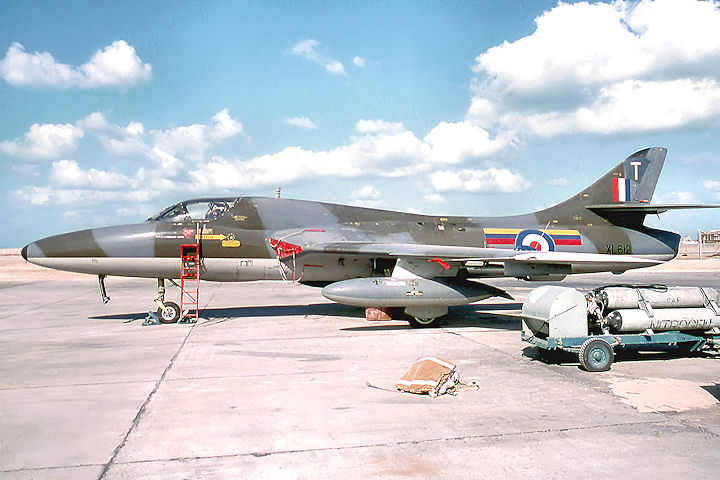Hunter T.Mk.7
Developed as a private Venture by Hawker Aircraft Ltd,
the first of 45 production Hunter T.Mk.7s for the RAF, XL563, first flew
on 11 October 1957 and deliveries to 229 OCU at Chivenor began in May
1958. The basic airframe was identical to the F.Mk.4, the main
exception being an extended front section containing a side-by-side
cockpit. In place of the standard Aden four-cannon gunpack, a single 30mm
cannon was fitted to the underside of the forward fuselage, offset to
the starboard side, sword-tooth extensions were fitted to the wing
leading edges and a braking parachute mounted on top of the rear fuselage.
Power was provide by a Rolls Royce Avon 122 which retained the cartridge
start system from the Mark 4. Despite a reduction in power compared to
the Mark 9 and 10, the area rule principle generated by the more bulbous
front fuselage, enabled the trainer to attain a maximum speed that was only 20 mph
slower the its more powerful cousins.
 |
|
The Hunter T.7 proved to be an invaluable
asset for the MEAF squadrons, not only for regular instrument
rating checks but with familiarising new pilots with the hostile
terrain over which they would be operating. Equipped with
four rocket rails and a single 30 mm cannon, the T.7 was also
used to support the FGA.9s in attacking ground targets up
country during periods of high unserviceability. XL612/T, seen
here at RAF Sharjah bearing 8 Squadron colours, would
ultimately have the privilege of being the last RAF Hunter in
operational service, its final flight taking place in August
2001 at Boscombe Down. (authorís collection) |
To prepare pilots for the conversion from Venom to
Hunter in Aden, two T.Mk.7s (XL613-Z and XL615-Y) were delivered to 8
Squadron at Khormaksar in September 1959. After XL615 was lost in a
crash in the following year, XL565-Y was sent out from the UK as a replacement. No. 208 Squadron which
reformed with the Hunter FGA.Mk.9 between March and June 1960 received a single
example (XL597-N), as did No. 43 Squadron (XL566-T) when it converted to
the Mark 9, also in 1960. Initially, the aircraft received the tailcodes
indicated above. With the reformation of 1417 Flt in 1963, all four Mark
7s were transferred to the Flight and loaned to the three
units when required. Apart from tailcodes W-Z, no unit
markings were applied until sometime around 1965, when the markings of 8 and 43 Squadrons
and 1417 Flight were added, together with pilots' initials on the fins
and nosewheel doors.
Despite its principle task being of pilot trainer, the
Aden-based T.Mk.7s were occasionally called upon to perform in the
ground attack role during periods of low serviceability on the Mark 9s.
A pair of rocket rails were fitted between the pylons of each wing and
the single cannon would keep heads down, particularly when H.E.
ammunition was
used.
